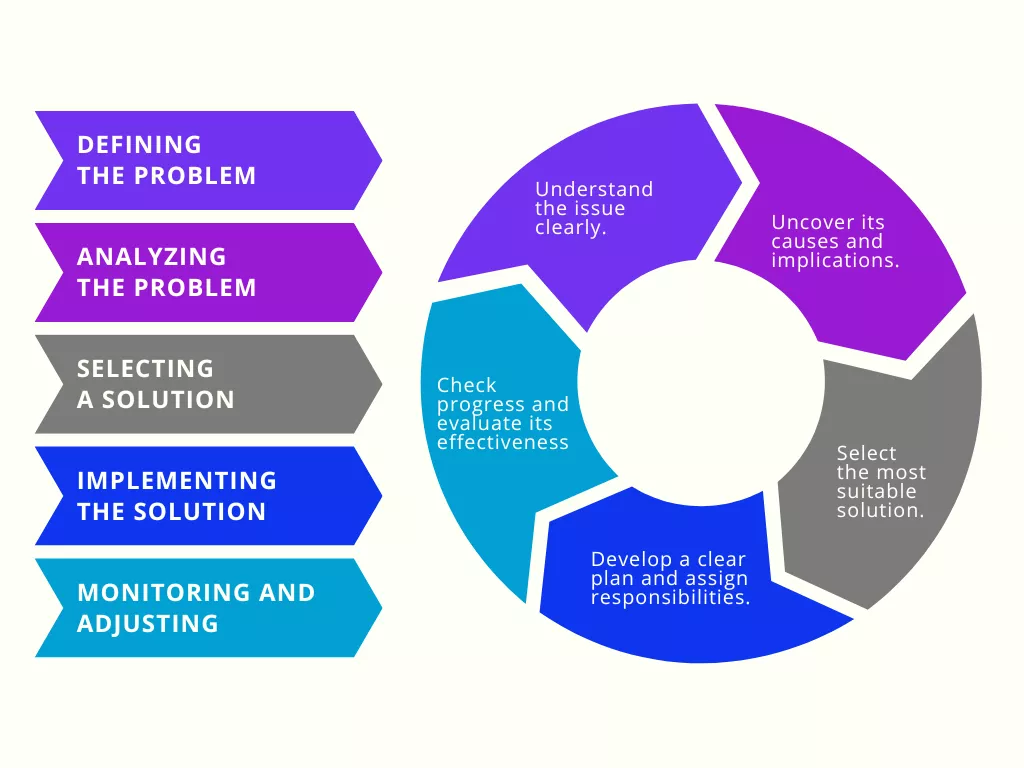By Team SOLVEDIO │ Updated Jun 13, 2023
Introduction
In business, challenges are inevitable. A problem in business occurs when what you want to happen doesn't match what's happening, and finding a solution can be challenging. Problem-solving in business involves identifying, analyzing, and solving problems to improve productivity, perfect performance, and achieve strategic goals. Business problem-solving involves implementing effective processes to overcome obstacles that stand in the way of achieving your operational and strategic goals. Successful businesses embrace problems as opportunities for growth and improvement instead of seeing them as obstacles.
Common Problems Faced by Businesses
Businesses face many challenges on their path to success. From quality issues and operational inefficiencies to supply chain disruptions and cost control, these common problems can hinder productivity and profitability.
- Supply chain disruptions: Businesses often rely on complex supply chains to source raw materials and components. Any disruption in the supply chain can lead to delays, shortages, and increased costs.
- Quality control issues: Keeping consistent product quality is crucial for businesses. However, manufacturing defects, equipment malfunctions, or human errors can result in defective products, customer dissatisfaction, and potential recalls.
- Operational inefficiencies: Inefficient processes and workflows can hinder productivity and increase costs. Common issues include inadequate production planning, poor inventory management, excessive downtime, or ineffective communication between different departments.
- Workforce management: Managing a diverse workforce and ensuring employee satisfaction can be challenging. Problems can arise from a lack of skilled workers, high turnover rates, poor employee attendance, or team conflicts.
- Regulatory compliance: Businesses must follow various regulations and standards, varying depending on the industry and location. Non-compliance can lead to fines, legal issues, damage to the company's reputation, and even closure.
- Technology integration: Adopting new technologies or upgrading existing systems can be complex and costly. Integration challenges, employee resistance, and the need for specialized ability can pose hurdles to successful technology implementation.

Importance of Problem Statement and Problem-solving in Business
To effectively solve business problems, gaining a deep understanding of their nature and root causes is essential, which requires careful analysis and critical thinking. Problems can manifest in different forms, ranging from minor operational glitches to complex strategic dilemmas. By understanding the intricacies of these problems, businesses can devise targeted solutions that address the core issues and lead to sustainable outcomes.
Problem statement refers to clearly defining a problem, understanding its underlying causes, and setting specific goals and aims to address it. On the other hand, problem-solving involves analyzing the identified problem and devising strategies to overcome it. Effective problem statement lays the foundation for successful problem-solving.
Problem-solving is a vital competency for individuals and organizations alike. It enables businesses to tackle challenges head-on, adapt to changing circumstances, and seize opportunities. Effective problem-solving fosters innovation, enhances decision-making, boosts operational efficiency, and drives business growth. By encouraging a problem-solving culture, companies can nurture a proactive mindset that empowers employees at all levels to contribute to the organization's success.
The Process of Problem-solving
Problem-solving in business involves a structured approach to identifying, analyzing, and solving problems. It's a way to enhance productivity, perfect performance, and achieve strategic goals. Let's break down the necessary steps:
1. Defining the Problem
The first step is to understand the issue clearly, which involves articulating the problem, understanding its impact on the business, and envisioning the desired outcome.
2. Gathering Information
Once the problem is defined, it's important to gather relevant information, including data, feedback, stakeholder insights, market research, and internal resources. This information forms the foundation for further analysis and decision-making.
3. Analyzing the Problem
Thoroughly examining the problem is crucial to uncover its causes and implications. Tools like root cause analysis, SWOT analysis, and fishbone diagrams can help understand the underlying factors comprehensively.
4. Generating Solutions
Generating solutions is the creative phase, where you brainstorm and generate various potential solutions. Encourage diverse perspectives and innovative thinking to explore different ideas and options.
5. Evaluating and Selecting a Solution
Once you have generated a range of solutions, it's time to evaluate them based on predetermined criteria. Consider factors such as feasibility, cost-effectiveness, and alignment with strategic goals. Select the most suitable solution for further implementation.
6. Implementing the Solution
With the chosen solution in hand, it's time to implement it. Develop a clear plan, assign responsibilities, and give necessary resources. Effective communication and collaboration are essential during this phase.
7. Monitoring and Adjusting
After implementing the solution, check its progress and evaluate its effectiveness. Regular monitoring allows for prompt adjustments and fine-tuning, ensuring that the solution continues to address the problem efficiently.

Challenges in Problem-solving
Problem-solving is a complex process that involves various challenges. One of these challenges is lack of data. When businesses have limited access to relevant data and insights, it becomes increasingly difficult to identify and understand the root causes of problems. Another common obstacle in problem-solving is ineffective collaboration. Departments within a business may operate in silos, isolating valuable information and perspectives. Poor communication further compounds the problem, hindering the collective effort to solve issues.
Time constraints also pose a significant challenge in problem-solving. In a rapidly changing business landscape, quick decision-making and problem resolution are vital. However, the need for speed often hampers the thorough analysis and evaluation of potential solutions. Time limitations prevent businesses from conducting a comprehensive examination of all available options, potentially leading to suboptimal or short-term fixes that do not address the root causes.
To overcome these challenges, businesses must prioritize data accessibility, collaboration, and time management in their problem-solving endeavors.
Problem-solving in Business
Digital Tools for Problem-solving in Business
You can significantly enhance your organizational performance by addressing your business's quality issues, operational inefficiencies, supply chain disruptions, or cost control. One effective approach is to digitize your problem-solving process and use customizable digital tools. These tools use advanced technologies such as artificial intelligence, data analytics, and automation to enhance problem-solving capabilities. The benefits of using problem-solving digital tools include:
- Data-driven insights: Problem-solving tools provide businesses with real-time data and analytics, enabling informed decision-making and more accurate problem diagnosis.
- Collaboration and knowledge sharing: These tools facilitate team collaboration by providing a centralized platform for sharing information, ideas, and solutions.
- Process optimization: Problem-solving digital tools streamlines and automates processes, reducing manual effort and enabling faster and more efficient problem resolution.
Solvedio's Problem-solving Solution
Solvedio is a platform that offers digital solutions for problem-solving in manufacturing and business. By leveraging the power of technology, Solvedio provides an intuitive and efficient way to streamline your problem-solving process.
Solvedio's Problem-solving Solution revolutionizes organizations' problem-solving and resolution approach, offering a streamlined and efficient cloud-based tool. It enables quick problem recording with easy attachment and photo integration, eliminating manual spreadsheet entry. The platform provides a comprehensive overview of ongoing issues, offers popular problem-solving methods, and ensures faster and more efficient resolution. Automation escalates problems quickly and suggests suitable solvers, leading to optimal results. Solvedio also enables the creation of lasting solutions, preventing problem recurrence and facilitating uninterrupted workflow for employees.
Irrespective of your company's industry, size, or the specific challenges you encounter, Solvedio provides a fully customizable solution to digitize problem-solving within your business. With Solvedio, you can choose and utilize only the features that align with your unique needs. This tailored approach ensures maximum efficiency and lets you derive the most significant value from the platform. By leveraging Solvedio, you can optimize your problem-solving processes and unlock enhanced organizational productivity.

Benefits of Effective Problem-solving
Adopting effective problem formulation and problem-solving strategies offers numerous benefits for businesses.
✔️Increased Efficiency and Productivity
By addressing problems proactively, businesses can streamline processes, eliminate bottlenecks, and enhance overall efficiency and productivity, which leads to cost savings and improved operational performance.
✔️Enhanced Decision-Making Capabilities
Effective problem-solving provides businesses with a clear understanding of the issues, enabling informed decision-making, which reduces the likelihood of making hasty or ill-informed decisions that could have adverse consequences.
✔️Improved Customer Satisfaction
Swift problem-solving helps resolve customer issues promptly, improving customer satisfaction and loyalty. Satisfied customers are more likely to become brand advocates and refer others, contributing to business growth.
✔️Competitive Advantage in the Market
Organizations that excel in problem-solving gain a competitive edge in the market. Their ability to address challenges efficiently and innovate solutions sets them apart from competitors and enhances their reputation.
Conclusion: Embrace, Analyze, Solve
In a rapidly changing business landscape, problem-solving is essential for growth and resilience. By adopting a structured approach and utilizing digital tools like Solvedio, businesses can navigate challenges, unlock innovation, and achieve sustainable success. Remember, every problem is an opportunity in disguise. Embrace it, analyze it, and solve it. Your business's future depends on it.
What is problem-solving in business?
In business, problem-solving is a systematic approach to identifying, analyzing, and resolving issues or obstacles that impede organizational goals. It involves the application of critical thinking, analytical skills, and decision-making techniques to find optimal solutions.
Why is problem-solving important in business?
Problem-solving is crucial in business as it enables organizations to overcome challenges, make informed decisions, and drive innovation. Effective problem-solving helps improve efficiency, productivity, and profitability while fostering a proactive and adaptable work environment.
What are some problem-solving methodologies in business?
There are several problem-solving methodologies used in business, including the 5 Whys technique, SWOT analysis (Strengths, Weaknesses, Opportunities, Threats), Fishbone Diagram, Pareto analysis, root cause analysis, brainstorming, Lean management, and agile problem-solving.
How can digital tools like Solvedio help with problem-solving in manufacturing/business?
Digital tools like Solvedio offer intuitive platforms that streamline problem-solving. Solvedio automates and simplifies the entire problem-solving process, offering digitized processes and problem-solving techniques. With one intuitive interface, you have everything you need to efficiently tackle problem formulation and the whole problem-solving process in your company without complex setups, procedures, or documentation.
